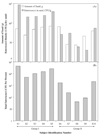Quantitative evaluation of bacteria released by bathers in a marine water
- PMID: 17113123
- PMCID: PMC2633726
- DOI: 10.1016/j.watres.2006.10.005
Quantitative evaluation of bacteria released by bathers in a marine water
Abstract
Enterococci, a common fecal indicator, and Staphylococcus aureus, a common skin pathogen, can be shed by bathers affecting the quality of recreational waters and resulting in possible human health impacts. Due to limited information available concerning human shedding of these microbes, this study focused on estimating the amounts of enterococci and S. aureus shed by bathers directly off their skin and indirectly via sand adhered to skin. Two sets of experiments were conducted at a marine beach located in Miami-Dade County, Florida. The first study, referred to as the "large pool" study, involved 10 volunteers who immersed their bodies in 4700L during four 15min cycles with exposure to beach sand in cycles 3 and 4. The "small pool" study involved 10 volunteers who were exposed to beach sand for 30min before they individually entered a small tub. After each individual was rinsed with off-shore marine water, sand and rinse water were collected and analyzed for enterococci. Results from the "large pool" study showed that bathers shed concentrations of enterococci and S. aureus on the order of 6x10(5) and 6x10(6) colony forming units (CFU) per person in the first 15min exposure period, respectively. Significant reductions in the bacteria shed per bather (50% reductions for S. aureus and 40% for enterococci) were observed in the subsequent bathing cycles. The "small pool" study results indicated that the enterococci contribution from sand adhered to skin was small (about 2% of the total) in comparison with the amount shed directly from the bodies of the volunteers. Results indicated that bathers transport significant amounts of enterococci and S. aureus to the water column, and thus human microbial bathing load should be considered as a non-point source when designing recreational water quality models.
Figures



References
-
- Alm EW, Burke J, Hagan E. Persistence and potential growth of the fecal indicator bacteria, Escherichia, in Shore-line Sand at Lake Huron. J. Great Lakes Res. 2006;32:401–405.
-
- Calderon RL, Mood EW, Dufour AP. Health effects of swimmers and nonpoint sources of contaminated water. Int. J. Environ. Res. 1991;1:21–31. - PubMed
-
- Charoenca N, Fujioka RS. Association of staphylococcal skin infections and swimming. Water Sci. Technol. 1995;31:11–17.
-
- Durbin ME, Zaher AM, Heybeck NF, Solo-Gabriele HM, Elmir SM, Goodwin KD, Sinigalliano C. The intertidal zone is the source of Enterococci to a subtropical recreational beach; Proceedings of the 105th General Meeting of the American Society for Microbiology; 2005. Abstract. Q-322.
Publication types
MeSH terms
Substances
Grants and funding
LinkOut - more resources
Full Text Sources

